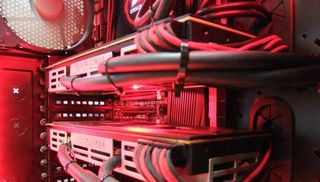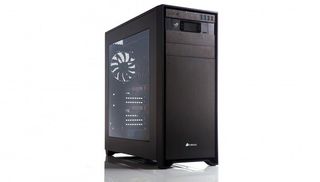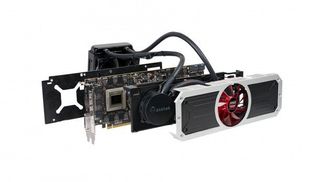Overclocker's Vesuvius PC tested: 4K gaming, powered by quadfire Radeon cards

The Infinity Vesuvius is a monster concocted by AMD and Overclockers, powered by a quadfire-tastic Radeon R9 295X2 pairing inside. Those four GPUs, housed in a sturdy Corsair chassis, will let you play at 4K resolutions without having to sacrifice top-end graphics settings, but you'll pay £4K / $6k for the privilege.

Inside, you'll find a quad-core Intel i7-4770K—so you're missing out on the hex-core you'll find in an Intel Extreme CPU. And there's only a 250GB Samsung SSD in there to back up the 2TB HDD. I'm a little less excited about the rest of the build than the two liquid-chilled graphical behemoths inside.
It's all about the quad graphics. And strapped to Asus' new £600 PB287Q screen, with its 3840x2160 resolution, 60Hz refresh and 1ms GtG, it does make a pretty pairing. The most impressive result from my afternoon's benchmarking was that the Vesuvius is capable of running Unigine's Heaven 4.0 benchmark at 4K, on Ultra settings with 4x AA at over 50fps on average. That's an incredible result, and demonstrates just how good the Hawaii GPU is at scaling across multiple GPUs.
One dual-GPU R9-295X2 will hit 30fps on average on its own. The extra two GPUs strapped boosted performance by 73%—an impressive result. Previously anything beyond a pair of GPUs would struggle to offer another 50% at best.

As for gaming performance, Battlefield 4 peaked at 68fps, dropping to a low of 41fps at worst. It's impressive, but it should be for that huge price tag. Overclockers will want their pet monster back soon enough, and in spite of the impressive numbers, I won't be selling my kidneys for a machine of my own.
The biggest gaming news, reviews and hardware deals
Keep up to date with the most important stories and the best deals, as picked by the PC Gamer team.

Dave has been gaming since the days of Zaxxon and Lady Bug on the Colecovision, and code books for the Commodore Vic 20 (Death Race 2000!). He built his first gaming PC at the tender age of 16, and finally finished bug-fixing the Cyrix-based system around a year later. When he dropped it out of the window. He first started writing for Official PlayStation Magazine and Xbox World many decades ago, then moved onto PC Format full-time, then PC Gamer, TechRadar, and T3 among others. Now he's back, writing about the nightmarish graphics card market, CPUs with more cores than sense, gaming laptops hotter than the sun, and SSDs more capacious than a Cybertruck.
Most Popular

